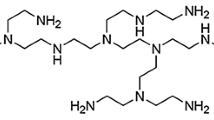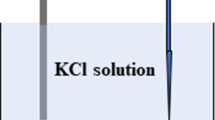Abstract
Previous studies suggest that bulk fluid flow by electroosmosis is a significant factor in iontophoresis and may provide an explanation for the observed enhanced transport of neutral species. In a charged membrane, the solution carries a net charge and thus experiences a volume force in an electric field, which causes volume flow (J v in the direction of counterion flow. J v data were obtained for hairless mouse skin (HM) as a function of pH, concentration of NaCl, current density, and time. Volume flow was measured by timing fluid movement in horizontal capillary tubes attached to the anode and cathode (Ag/AgCl) compartments. By convention, the sign of J v is taken as positive when the volume flow is in the same direction as positive current flow. Experimental mean values were in the range 0 to + 37 µl/cm2 hr, depending on the experimental conditions. Volume flow of this magnitude is large enough to have significant impact on flow of both ions and neutral species. The positive sign for J v indicates that HMS is negative in the pH range studied (3.8–8.3). J v decrease with time, decrease with increasing NaCl concentration, are much lower at pH 3.8 than at the higher pH's, and increase with current density. Effective transference numbers, determined from membrane potential measurements, showed significant pH dependence, consistent with a small negative charge on the membrane at mid pH's and charge reversal around pH 4. Both electrical resistance and J v data indicate changes in transport properties occur when HMS is subjected to an electric field.
Similar content being viewed by others
REFERENCES
M. J. Pikal. Pharm. Res. 7:118–126 (1990).
D. G. Miller. Chem. Rev. 60:15–37 (1960).
N. Lakshminarayanaiah. Chem. Rev. 65:491–565 (1965).
Y. Kobatake, M. Yuasa, and H. Fujita. J. Phys. Chem. 72:1752–1757 (1968).
H. Rein. Z. Biol. 81:125–140 (1924).
D. J. Ives and G. J. Janz. Reference Electrodes, Academic Press, New York, 1961, Chap. 4.
H. E. Gunning and A. R. Gordon. J. Chem. Phys. 10:126–131 (1942).
M. Spiro. Determination of transference numbers. In A. Weissberger (ed.), Physical Methods of Organic Chemistry, Part IV, 3rd ed, Interscience, New York, 1960, pp. 3049–3111.
G. Scatchard. J. Am. Chem. Soc. 75:2883–2887 (1953).
R. A. Robinson and R. H. Stokes, Electrolyte Solutions, 2nd ed, Academic Press, New York, 1959.
M. J. Pikal and D. G. Miller. J. Phys. Chem. 74:1337–1344 (1970).
D. G. Miller. J. Phys. Chem. 70:2639–2659 (1966).
R. Burnette and B. Ongpipattanakul. J. Pharm. Sci. 76:765–773 (1987).
M. J. Pikal and S. Shah. Pharm. Res. 7:222–229 (1990).
M. J. Pikal and G. E. Boyd. J. Phys. Chem. 77:2918–2924 (1973).
R. Burnette and D. Marrero. J. Pharm. Sci. 75:738–743 (1986).
R. R. Burnette and B. Ongpipattanakul. J. Pharm. Sci. 77:132–137 (1988).
R. R. Burnette and T. M. Bagniefski. J. Pharm. Sci. 77:492–497 (1988).
Author information
Authors and Affiliations
Rights and permissions
About this article
Cite this article
Pikal, M.J., Shah, S. Transport Mechanisms in Iontophoresis. II. Electroosmotic Flow and Transference Number Measurements for Hairless Mouse Skin. Pharm Res 7, 213–221 (1990). https://doi.org/10.1023/A:1015857608850
Issue Date:
DOI: https://doi.org/10.1023/A:1015857608850




